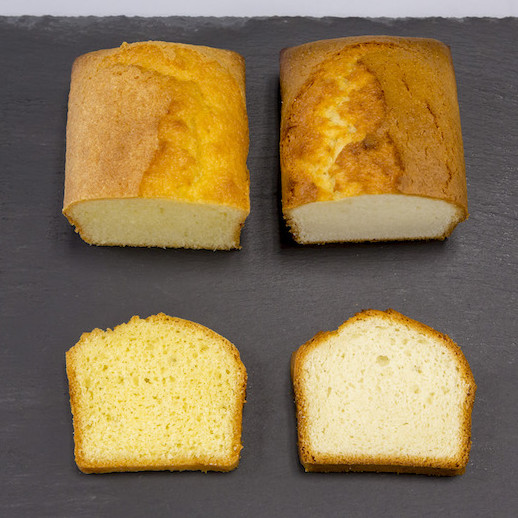Function
Designing ingredients as egg replacers in bakery applications requires a good understanding of egg functionalities in baked systems, which include: 1,2
- Foaming: important for formation of air cells in batters.
- Coagulation: heat setting and structure forming.
- Emulsification: important for consistency and texture
- Stabilization: essential for firmness and elasticity
- Moistening: important for the sensory perception in cakes, cookies, and waffles
- Color: natural yellow hue, and contribution to Maillard browning reaction.3
Egg replacement strategies
Many food and bakery systems can use egg replacement ingredients such as cakes, cookies, muffins, pie fillings, icings, etc. Commercially-available egg replacers are classified into three main categories: proteins, polysaccharides and emulsifiers:2
| Component | Functionality | Challenges |
|---|---|---|
| Proteins (whey, soy, wheat, pea, chickpea) |
|
|
| Polysaccharides /gums (xanthan, guar) |
|
|
| Emulsifiers (lecithin, sucrose esters) |
|
|
New plant based alternatives or their combinations have been used to effectively replace eggs in certain baked goods including:3,5
- Chia seed gel: provides similar emulsifying capacities to eggs when used at 25% level.
- Natural colors: lycopene, annatto, turmeric and paprika extracts can be used to substitute the yellow hue provided by egg yolk.
- Flaxseed gel: provides humectancy and binding capacity. Typically 1 egg is substituted by 1 tablespoon of flaxseed meal with 3 tablespoons of water.
- Fruit pureés: banana puree and applesauce provide some biding and humectancy capacity.
- Vegetable oils: used to replace egg wash to provide glow to baked goods.
- Algal flours: provide emulsifying and humectancy capacity due to the presence of phospholipids and starch.
Consideration when using egg substitutes: 3
- A combination of several substitutes yield better results than one single ingredient to perform all of the egg’s functions.
- Full egg replacement should be implemented when producing baked goods for egg-allergic consumers.
- Replacement level should be carefully designed when using substitutes with strong flavor that may change baked goods flavor profile.
Examples of egg substitutes ingredients combinations:3
| Substitute composition | Emulsifying | Binding | Humectancy | Color | Flavor |
|---|---|---|---|---|---|
| Algal flour
Gellan gum Carrageenan Cellulose Black salt |
+ | +
+ + |
+ | + | Black salt |
| Pea proteinGuar gum
Xanthan gum Beta carotene Black Salt |
+ | +
+ |
+ | Black salt | |
| Fortified nutritional yeast
Sodium alginate Beta carotene Black Salt |
+
+ |
+
+ |
+
+ |
+ | Black salt |
Regulations
Commercially available egg replaces such as alpha-cyclodextrin (GRN 678), xanthan gum (GRN 121), whey protein isolate (GRN 37), soy hydrogenated lecithin (GRN 534) are considered GRAS by the FDA when their usage adheres to good manufacturing practices. 6,7,8,9
EU Commission No 1308/2013 protects the use of terms like “eggs” for animal- based products.The EU is currently debating the legal status and labeling of agricultural products substitutes.10
References
- Feeney, R.E. “Egg Proteins”. In Symposium on Foods: Proteins and their reactions. H.W. Schultz, H.W., and Angelmiers, A.F., editors. Avi Publishing Co., Westport, CT (1964)
- Julianti, E., Rusmarilin, H., Yusriani, R.E. Effect of gluten-free composite flour and egg replacer on physicochemical and sensory properties of cakes. Int. Food Res. J. 2016, 23, 6: 2413-1418.
- Grizio, M, and Specht, L. “Plant-based egg alternatives: Optimizing for functional properties and applications.” The Good Food Institute. Recovered from https://gfi.org/images/uploads/2018/06/Plantbasedeggalternatives.pdf , 2018.
- Lin, M., Yang, H., Tay, S.H. and Li, H. Replacement of eggs with soybean protein isolates and polysaccharides to prepare yellow cakes suitable for vegetarians. Food Chem. 2017, DOI:10.1016/j.foodchem.2017.02.132
- Borneo R, Aguirre A and Leon, A.E. Chia (Salvia hispanica L) gel can be used as egg or oil replacer in cake formulations. Journal of the American Dietetic Association, 2010, 110, pp: 946-949.
- U.S. Food and Drug Administration. “GRAS Notices” Accessdata.fda.gov, https://www.fda.gov/downloads/Food/IngredientsPackagingLabeling/GRAS/NoticeInventory/UCM566349.pdf Accessed on August 24 2018.
- U.S. Food and Drug Administration. “GRAS Notices” Accessdata.fda.gov, https://www.accessdata.fda.gov/scripts/fdcc/?set=GRASNotices&id=121&sort=GRN_No&order=DESC&startrow=1&type=basic&search=xanthan%20gum Accessed on August 24 2018.
- U.S. Food and Drug Administration. “GRAS Notices” Accessdata.fda.gov, https://www.accessdata.fda.gov/scripts/fdcc/?set=GRASNotices&id=633&sort=GRN_No&order=DESC&startrow=1&type=basic&search=whey%20protein Accessed on August 24 2018.
- U.S. Food and Drug Administration. “GRAS Notices” Accessdata.fda.gov, https://www.accessdata.fda.gov/scripts/fdcc/?set=GRASNotices&id=534&sort=GRN_No&order=DESC&startrow=1&type=basic&search=lecithin Accessed on August 24 2018.
- European Commission (EC). Regulation (EU) No 1308/2013 Of The European Parliament And Of The CounciL of 17 December 2013 establishing a common organisation of the markets in agricultural products and repealing Council Regulations (EEC) No 922/72, (EEC) No 234/79, (EC) No 1037/2001 and (EC) No 1234/2007 .Official Journal of European Communities, 17 Dec 2013.

